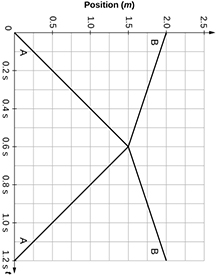-
Home
- College physics for ap® courses
- Linear momentum and collisions
- Elastic collisions in one
Which of the following statements is true about an inelastic collision?
- Momentum is conserved, and kinetic energy is conserved.
- Momentum is conserved, and kinetic energy is not conserved.
- Momentum is not conserved, and kinetic energy is conserved.
- Momentum is not conserved, and kinetic energy is not conserved.
Got questions? Get instant answers now!
Explain how the momentum and kinetic energy of a system of two colliding objects changes as a result of (a) an elastic collision and (b) an inelastic collision.
Got questions? Get instant answers now!

This figure shows the positions of two colliding objects measured before, during, and after a collision. Mass A is 1.0 kg. Mass B is 3.0 kg. Which of the following statements is true?
- This is an elastic collision, with a total momentum of 0 kg • m/s.
- This is an elastic collision, with a total momentum of 1.67 kg • m/s.
- This is an inelastic collision, with a total momentum of 0 kg • m/s.
- This is an inelastic collision, with a total momentum of 1.67 kg • m/s.
Got questions? Get instant answers now!
For the above graph, determine the initial and final momentum for both objects, assuming mass A is 1.0 kg and mass B is 3.0 kg. Also, determine the initial and final kinetic energies for both objects. Based on your results, explain whether momentum is conserved in this collision, and state whether the collision is elastic or inelastic.
Got questions? Get instant answers now!
Mass A (1.0 kg) slides across a frictionless surface with a velocity of 8 m/s in the positive direction. Mass B (3.0 kg) is initially at rest. The two objects collide and stick together. What will be the change in the center-of-mass velocity of the system as a result of the collision?
- There will be no change in the center-of-mass velocity.
- The center-of-mass velocity will decrease by 2 m/s.
- The center-of-mass velocity will decrease by 6 m/s.
- The center-of-mass velocity will decrease by 8 m/s.
Got questions? Get instant answers now!
Mass A (1.0 kg) slides across a frictionless surface with a velocity of 4 m/s in the positive direction. Mass B (1.0 kg) slides across the same surface in the opposite direction with a velocity of −8 m/s. The two objects collide and stick together after the collision. Predict how the center-of-mass velocity will change as a result of the collision, and explain your prediction. Calculate the center-of-mass velocity of the system both before and after the collision and explain why it remains the same or why it has changed.
Got questions? Get instant answers now!
Section summary
- An elastic collision is one that conserves internal kinetic energy.
- Conservation of kinetic energy and momentum together allow the final velocities to be calculated in terms of initial velocities and masses in one dimensional two-body collisions.
Conceptual questions
Problems&Exercises
Two identical objects (such as billiard balls) have a one-dimensional collision in which one is initially motionless. After the collision, the moving object is stationary and the other moves with the same speed as the other originally had. Show that both momentum and kinetic energy are conserved.
Got questions? Get instant answers now!
Professional Application
Two manned satellites approach one another at a relative speed of 0.250 m/s, intending to dock. The first has a mass of
, and the second a mass of
. If the two satellites collide elastically rather than dock, what is their final relative velocity?
Got questions? Get instant answers now!
A 70.0-kg ice hockey goalie, originally at rest, catches a 0.150-kg hockey puck slapped at him at a velocity of 35.0 m/s. Suppose the goalie and the ice puck have an elastic collision and the puck is reflected back in the direction from which it came. What would their final velocities be in this case?
Got questions? Get instant answers now!
Questions & Answers
calculate molarity of NaOH solution when 25.0ml of NaOH titrated with 27.2ml of 0.2m H2SO4
the study of the heat energy which is associated with chemical reactions
Kaddija
How was CH4 and o2 was able to produce (Co2)and (H2o
First twenty elements with their valences
what is the best way to define periodic table for jamb
what is the change of matter from one state to another
what is isolation of organic compounds
Read Chapter 6, section 5
Dr
Read Chapter 6, section 5
Kareem
Atomic radius is the radius of the atom and is also called the orbital radius
Kareem
atomic radius is the distance between the nucleus of an atom and its valence shell
Amos
Read Chapter 6, section 5
paulino
Bohr's model of the theory atom
when a gas is compressed why it becomes hot?
ATOMIC
It has no oxygen then
Goldyei
read the chapter on thermochemistry...the sections on "PV" work and the First Law of Thermodynamics should help..
Dr
Which element react with water
an increase in the pressure of a gas results in the decrease of its
definition of the periodic table
what were atoms composed of?
Got questions? Join the online conversation and get instant answers!
Source:
OpenStax, College physics for ap® courses. OpenStax CNX. Nov 04, 2016 Download for free at https://legacy.cnx.org/content/col11844/1.14
Google Play and the Google Play logo are trademarks of Google Inc.

